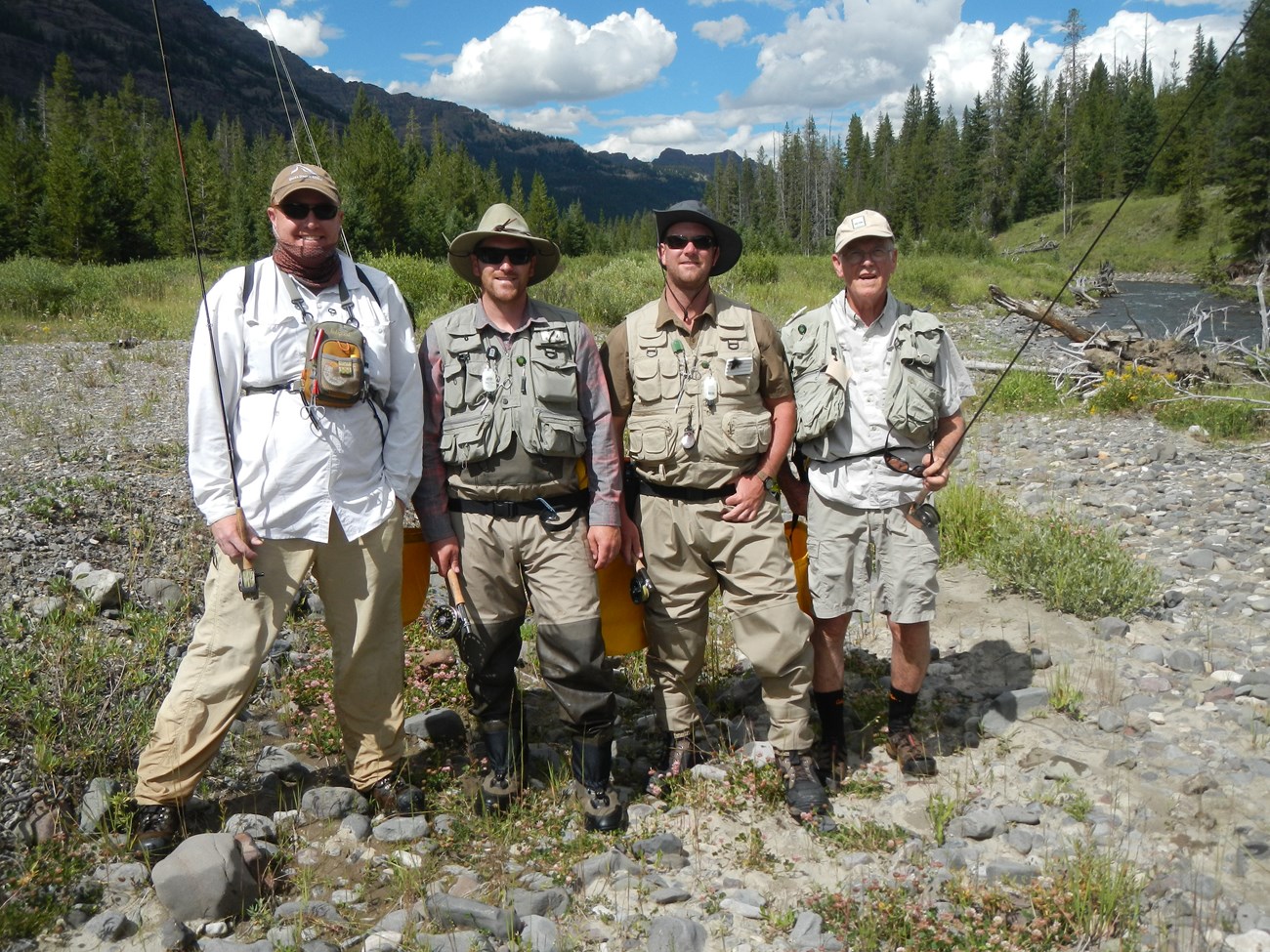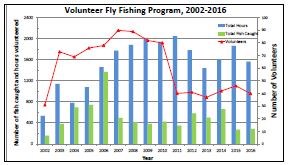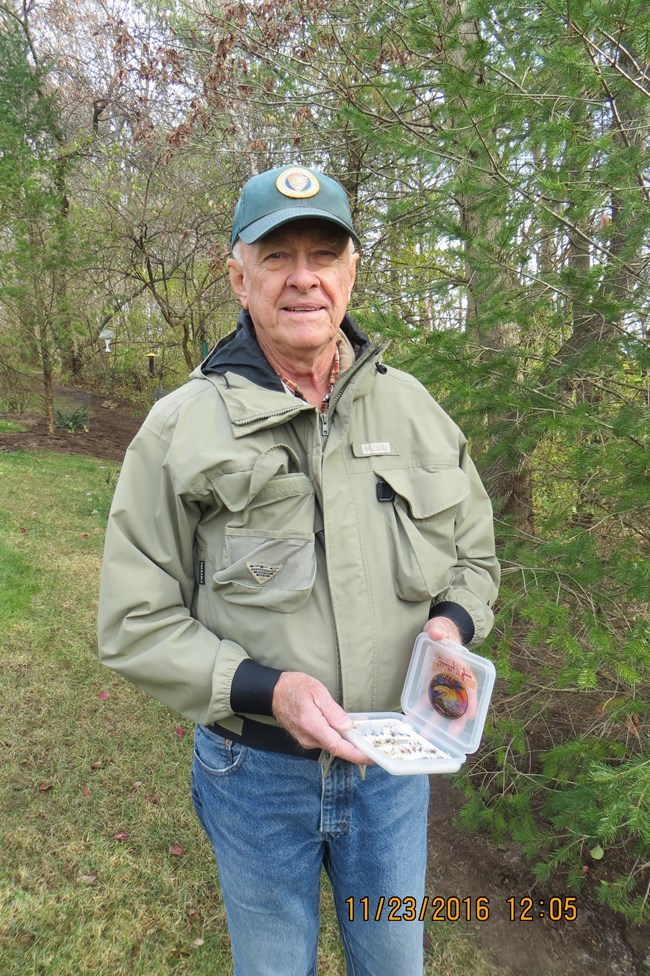Article
Fly Fishing Volunteers Support Native Fish Conservation in Yellowstone

The Yellowstone Fly Fishing Volunteer Program was conceived in 2002 as a way Yellowstone’s biologists could acquire information about fish populations without having to travel to distant locations throughout the park and sample the populations themselves using electrofishing or other sophisticated gear. Yellowstone National Park contains an estimated 4,265 km (2,650 mi.) of streams and more than 150 lakes, many of which support native fish populations that could be monitored; however, emerging resource concerns such as the invasion of non-native lake trout and whirling disease occupy progressively more time and financial resources of the park’s fisheries program. As a way to sample fish populations and address fisheries issues park biologists would otherwise not be able to do, the fly fishing volunteers use angling to gather and archive information and biological samples.
Each year, a list of projects is developed by park biologists, so volunteers can focus their efforts. In its early years, the program was led by Timothy Bywater, an avid fly fisher and supporter of Yellowstone’s native fish conservation program. William Voigt, also an avid fly fisher, joined the program in 2004 and eventually took over the job of program coordinator. Over the years, hundreds of fly fishers have volunteered with the program. These volunteers are important to the conservation of Yellowstone’s native fish in a myriad of ways. They provide data and collect samples in important project areas, as well as in areas we may not know much about. They also play an important role in communicating with the public. They interact with tourists and other fly fishers on a regular basis and are able to discuss important topics, such as park fishing regulations, the reasoning behind some of the more controversial restoration projects, and why native fish are an important resource in Yellowstone.
How They Contribute
The volunteer fly fishing program attracts anglers from all across the United States, many of whom choose to come back year after year. Since the start of the program, 914 volunteers have contributed almost 23,000 hours to support native fish conservation in Yellowstone (figure 1). Of the 914 volunteers, 309 have returned for more than one season. These volunteers perform a wide range of duties in assisting the Yellowstone fisheries program, providing everything from logistical support to extensive sample collection. Collectively, program volunteers have sampled 7,000 fish since 2002 via angling. Data collected from each fish is recorded on datasheets and archived in computer databases. Along with fish lengths, weights, condition, and other basic data, volunteers also collect biological samples to be later processed in a laboratory. For example, volunteers have been integral in collecting genetic samples from various locations. Most notably, the samples they collected from the Lamar River and Slough and Soda Butte creeks aided park managers in understanding the extent of cutthroat trout hybridization in these drainages, thus contributing to subsequent management decisions. Other genetic sampling efforts across the park have been used to confirm or dismiss the presence of hybridization in a population, again aiding park biologists in management decisions. Between 2007 and 2014, volunteers collected 263 genetic samples from the Slough Creek drainage alone.The volunteer fly fishers also provide invaluable support for fish tagging projects, such as those conducted on the Gibbon and Lamar rivers. These projects provide information on the life history and movement of species, such as Arctic grayling (Gibbon River) and rainbow trout and cutthroat rainbow trout hybrids (Lamar River and Slough and Soda Butte creeks). The collection of fish large enough to tag and for insertion of the tag itself can be an arduous process. During 2015, the volunteer fly fishing program caught and tagged approximately 220 fish in the Lamar River system. With the help of the volunteer program, biologists and collaborating graduate students were able to work more efficiently and effectively, ultimately providing managers with the best data possible.
Since the start of the program, volunteers have also assisted with several other projects, including removal of non-native species, evaluation of fish barrier efficacy and success, a study to determine injury and mortality rates when using barbed versus barbless hooks, surveys to determine species composition, and logistical support for large multi-agency projects.

Their Role with the Public
In addition to providing valuable data, samples, and assistance to the fisheries program, volunteer fly fishers play an important role with the public. The program itself gives dedicated anglers a chance to contribute to fish conservation efforts in a positive way. Through their role as volunteers, they are able to positively interact with the public and demonstrate their passion for native fish and the importance of protecting these species. Volunteer fly fishers promote an understanding of the park’s fishing policies and regulations, and generate awareness of the current issues facing Yellowstone’s native fish. Passionate and informed supporters such as these are an important contribution to the success of native fish conservation in Yellowstone.Shared Experiences
Over the years the Yellowstone Fly Fishing Volunteer Program has been in existence, there have been many experiences shared among the coordinators and participating volunteers. Notes are taken by the volunteer coordinator during field outings with volunteers; below are three examples of those notes.Cache Creek
“Today, August 11, 2005, we hiked 3 miles up the Lamar River Trail to collect genetic samples from the Cutthroat Trout in Cache Creek. It started bright and sunny but as the afternoon progressed many thunderstorms passed around us. We fished a half mile of the stream and took fin clips and scale samples from 20 fish. There wasn’t any hatch but fish rose to our hopper and caddis patterns. With more storms threatening, we headed back down the trail to the parking lot. It was obvious that it had rained hard along the Soda Butte Creek because the trail and the creek were muddy.
As we loaded our gear into our van, two park ranger cars blocked us in and the rangers demanded to see our licenses and fish. They had a report of six people catching fish and keeping them in yellow buckets up on Cache Creek. After some explanation of the program, one of the rangers remembered fishing with Tim Bywater the previous year. One of our volunteers was quite a large lad with a voracious appetite and had brought half of a pork roast in his pack for lunch. We teased him that one of the rangers was eyeing him up to decide how to take him down if he was to run. We all chuckled.
The Lamar valley is becoming one of our favorite places in the park. The broad vistas of the valley are quite spectacular! We saw bison, pronghorns, and a coyote as well as a kestrel hunting in the meadows. It was great day!”
High Lake
“High Lake was the first body of water recently reclaimed for West Slope [sic] Cutthroat Trout. Now, two years later Colleen Detjens (see page 27) in August 2009, we were going to High Lake for two days of fishing for West Slope [sic] Cutthroat Trout. This was our first horse-packing trip in the park and we all were excited. Our volunteers were so eager that they willingly rented their own horses and brought their own supplies and equipment. We were to weigh and measure every fish we caught. We were also to record whether the adipose fin had been clipped. That would indicate that they had been stocked as fingerlings. If the adipose fin was intact, they had hatched from egg boxes put in the spring feeding the lake or from natural reproduction.
It was a ten mile ride up to the lake on top of the mountain very close to the northwest border of the park. We set up camp and then started fishing. We caught many fish in the 11 to 11 ¾ inch range with their adipose fin clipped; so many so that a competition was occurring to see who would catch the first 12 inch fish. However, several smaller fish were caught with their fins intact. The lake and its fish seemed to be doing well; we caught 67 fish over the course of two days.
The days were pleasant, but the nights were very cold. Hot chocolate was welcome in the morning. And no one caught that 12 inch fish.”

“Our destination in July 2011, was Pelican Creek. We hiked 1.5 miles up the trail to the creek with 2 volunteers. The creek had been closed for seven years because of the discovery of whirling disease and had just been reopened. We were to sample the Yellowstone Cutthroat trout population to see how their recovery was progressing. During the course of the sunny day, we saw a few elk, a grizzly bear, a small herd of bison, a Trumpeter swan, and a Swainson’s hawk. Fishing was slow, but we caught two 19” cutthroat trout obviously up from the lake to spawn. On our way out, one of our volunteers turned to us, and even though he didn’t catch any fish, he said, ‘Thank you. You took me to a beautiful place I would never have seen on my own.’
Several days later we went back up Pelican Creek with writer Nate Schweber and caught several 5-6 inch healthy-looking Yellowstone Cutthroat trout. Schweber dedicated the final chapter of his book, Fly Fishing Yellowstone National Park, to the recovery of Pelican Creek.”
